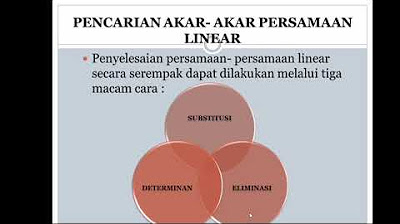Solving Linear Systems Using SUBSTITUTION | Math10 | jensenmath.ca
Summary
TLDRThis educational video script introduces the method of substitution for solving linear systems, emphasizing the importance of finding exact solutions. It outlines three possible outcomes: a single solution when lines intersect, no solutions when lines are parallel and distinct, and infinite solutions when lines are coincident. The script guides viewers through five steps of the substitution method, including isolating a variable, substituting it into the other equation, solving for the variable, and checking the solution in both original equations. Four examples illustrate these scenarios, providing a clear understanding of solving linear systems algebraically.
Takeaways
- 📚 The lesson focuses on solving linear systems using the substitution method, which provides exact answers compared to graphical estimations.
- 🔍 There are three possible scenarios when solving a linear system: intersection, parallel and distinct lines, and parallel and coincident lines.
- 📈 The first scenario involves lines with different slopes intersecting at a point, leading to a single solution.
- 🚫 The second scenario features parallel but distinct lines that never intersect, resulting in no solutions algebraically shown by an unsolvable equation like 0x = 5.
- ∞ The third scenario describes parallel and coincident lines with the same slope and intercepts, offering infinite solutions, indicated algebraically by an equation like 0x = 0.
- 📝 The substitution method involves five steps: isolating a variable, substituting it into the other equation, solving for the remaining variable, finding the value for the second variable, and checking the solution in both original equations.
- 🔑 The choice of which variable to isolate often depends on finding a coefficient of one or the smallest coefficient for ease of calculation.
- 📉 When substituting, it's crucial to ensure that the x variables in both equations are equal, leading to an equation with a single variable to solve.
- 🔄 The process involves simplifying and rearranging equations to isolate and solve for variables, often starting with distributing and combining like terms.
- 📝 A correct solution must satisfy both original equations, which is verified by substituting the found values back into the equations and checking both sides for equality.
- 📚 The lesson concludes with a preview of the next method for solving linear systems, which is elimination, suggesting a continuation of the algebraic approach to these problems.
Q & A
What is the main goal of solving a linear system?
-The main goal of solving a linear system is to find the values of the variables that satisfy all of the equations in the system, which can be graphically represented as the point of intersection of the lines.
What are the three scenarios that can occur when solving a linear system?
-The three scenarios are: 1) The lines intersect, meaning there is a single solution. 2) The lines are parallel and distinct, meaning there are no solutions. 3) The lines are parallel and coincident, meaning there are an infinite number of solutions.
What is the algebraic method called that is taught in this lesson?
-The algebraic method taught in this lesson is called substitution.
How many steps are there in the substitution method for solving linear systems?
-There are five steps in the substitution method: 1) Rearrange one of the original equations to isolate a variable. 2) Substitute the isolated variable into the other equation. 3) Solve the new equation for the remaining variable. 4) Plug the answer back into one of the original equations to solve for the other variable. 5) Check the solution in both equations.
Why is it easier to isolate a variable with a coefficient of one?
-It is easier to isolate a variable with a coefficient of one because it simplifies the process of rearranging the equation, as you do not need to divide or multiply through by the coefficient.
What does it mean if you end up with an equation like 0x = 5 during the substitution process?
-If you end up with an equation like 0x = 5 during the substitution process, it indicates that there are no solutions to the linear system because there is no value for x that can satisfy the equation.
How can you identify when the lines represented by the equations are parallel and coincident?
-You can identify when the lines are parallel and coincident if, during the substitution process, you end up with an equation that is true for all values of the variable, such as 0x = 0.
What is the purpose of checking the solution in both original equations?
-The purpose of checking the solution in both original equations is to verify that the found values of x and y indeed satisfy both equations, ensuring the accuracy of the solution.
Can you provide an example of a situation where the substitution method would yield infinitely many solutions?
-The substitution method would yield infinitely many solutions when the lines represented by the equations are parallel and coincident, as in the case where the equations have the same slope and intercepts, and the substitution process results in an equation like 0y = 0.
What is the next algebraic method for solving linear systems that will be taught after substitution?
-The next algebraic method for solving linear systems that will be taught after substitution is called elimination.
Outlines

此内容仅限付费用户访问。 请升级后访问。
立即升级Mindmap

此内容仅限付费用户访问。 请升级后访问。
立即升级Keywords

此内容仅限付费用户访问。 请升级后访问。
立即升级Highlights

此内容仅限付费用户访问。 请升级后访问。
立即升级Transcripts

此内容仅限付费用户访问。 请升级后访问。
立即升级浏览更多相关视频

Solve a Linear System by Graphing | jensenmath.ca | grade 10

Sistem persamaan linear dua variabel (SPLDV) Metode subtitusi, Eliminasi dan Campuran

5 MTK EKO PENCARIAN AKAR AKAR PERS LINEAR

SOLVING SYSYEM OF NONLINEAR EQUATIONS || PRECALCULUS

Kurikulum Merdeka Matematika Kelas 9 Bab 1 Sistem Persamaan Linear Dua Variabel

Solving Systems of Equations in Two Variables
5.0 / 5 (0 votes)
